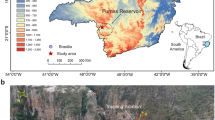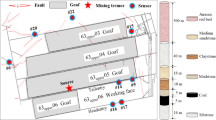Abstract
Tunnels crossing active faults can be severely damaged by fault dislocation. Based on a freeway tunnel crossing an active fault, a three-dimensional numerical model is established to investigate the influences of the friction coefficient and position of the dislocation surface on the tunnel response under the action of right-lateral strike-slip reverse fault dislocation. The results show that the friction coefficient of the dislocation surface has little effect on the deformation characteristics in the tunnel but has a slight effect on the stress distribution. As the friction coefficient increases from 0.3 to 1.0, the stress distribution shape in the tunnel basically remains unchanged, while the maximum absolute values of the principal stresses decrease. The dislocation position has a significant effect on the deformation and stress distribution in the tunnel. When the fault moves along the interface between the fracture zone and the intact rock mass in the hanging wall or footwall, the deformation of the tunnel is the most severe, and the local stress concentration is also the most severe. In view of the local damage, amongst the conditions studied here, the condition of fault dislocation occurring along the interface between the fracture zone and the intact rock mass is the most dangerous and the condition of dislocation occurring along the fracture zone is safest. Under fault dislocation, the tunnel deformation is the most obvious in the fracture zone and tends to decrease to both sides; the principal stress in the tunnel peaks in the fracture zone and decreases to the two sides. The tunnel may be seriously damaged in the fracture zone and fault walls within 5 m of both sides of the fracture zone, and the tunnel fortification length is 3.39 times the fault width of 90 m. Disaster mitigation measures should be adopted for the tunnel design within the fortification range.
















Similar content being viewed by others
Availability of data and materials
The data used to support the findings of this study are available from the corresponding author upon reasonable request.
References
An S, Tao LJ, Bian J (2020) Study on anti-faulting design process of Urumqi subway line 2 tunnel crossing reverse fault. J Southeast Univ (Engl) 36(4):425–435. https://doi.org/10.3969/j.issn.1003-7985.2020.04.008
An S, Tao LJ, Zhang XC (2021) Application of two-level design method on subway tunnel crossing active fault: a case study on Urumqi subway tunnel intersected by reverse fault dislocation. Bull Eng Geol Environ 80:3871–3884. https://doi.org/10.1007/s10064-021-02164-y
Anastasopoulos I, Gazetas G (2007) Foundation-structure systems over a rupturing normal fault: Part I. Observations after the Kocaeli 1999 earthquake. Bull Earthq Eng 5:253–275. https://doi.org/10.1007/s10518-007-9029-2
Asakura T, Sato Y (1996) Damage to mountain tunnels in hazard area. Soils Found 36:301–310. https://doi.org/10.3208/sandf.36.Special_301
Baziar MH, Nabizadeh A, Lee CJ, Hung WY (2014) Centrifuge modeling of interaction between reverse faulting and tunnel. Soil Dyn Earthq Eng 65:151–164. https://doi.org/10.1016/j.soildyn.2014.04.008
Burridge PB, Scott RF, Hall JF (1989) Centrifuge study of faulting effects on tunnel. J Geotech Eng 115(7):949–967. https://doi.org/10.1016/0148-9062(90)90407-S
Byerlee J (1978) Friction of rocks. Pure Appl Geophys 116:615–626. https://doi.org/10.1007/BF00876528
Cui GY (2012) The seismic design calculation method and test study of tunnel shallow-buried portal and rupture stick-slipping section. Dissertation, Southwest Jiaotong University (in Chinese)
Cui Z, Li JH, Fu XW, Sheng Q, Zhou GX, Ma YLN, Wang TQ (2022) Evaluating the response of a tunnel subjected to strike-slip fault rupture in conjunction with model test and hybrid discrete-continuous numerical modeling. Rock Mech Rock Eng 55:4743–4764. https://doi.org/10.1007/s00603-022-02900-0
Deng QD, Yu GH, Ye WH (1992) Relationship between earthquake magnitude and parameters of surface rupture associated with historical earthquakes. Res Act Fault 2:247–264 (in Chinese)
GB 50010-2010 (2010) Code for design of concrete structures. China Architecture & Building Press, Beijing (in Chinese)
Hashash YMA, Hook JJ, Schmidt B, Yao JIC (2001) Seismic design and analysis of underground structures. Tunn Undergr Space Technol 16(4):247–293. https://doi.org/10.1016/S0886-7798(01)00051-7
Huang QB, Peng JB, Deng YH, Fan W (2010) Design parameters of Xi’an metro line 2 tunnel passing through active ground fissure zones. Rock Soil Mech 31(9):2882–2888. https://doi.org/10.16285/j.rsm.2010.09.012. (in Chinese)
Huang RQ, Li YR, Qu K, Wang K (2013) Engineering geological assessment for route selection of railway line in geologically active area: a case study in China. J Mt Sci 10:495–508. https://doi.org/10.1007/s11629-013-2660-2
Kennedy RP, Chow AW, Williamson RA (1977) Fault movement effects on buried oil pipeline. ASCE J Transp Eng 103(5):617–633. https://doi.org/10.1061/TPEJAN.0000659
Kiani M, Akhlaghi T, Ghalandarzadeh A (2016) Experimental modeling of segmental shallow tunnels in alluvial affected by normal faults. Tunn Undergr Space Technol 51:108–119. https://doi.org/10.1016/j.tust.2015.10.005
Liu GZ, Qiao YF, He MC, Fan Y (2020) An analytical solution of longitudinal response of tunnels under dislocation of active fault. Rock Soil Mech 41(3):923–932. https://doi.org/10.16285/j.rsm.2019.0585. (in Chinese)
Liu XZ, Li XF, Sang YL, Lin LL (2015) Experimental study on normal fault rupture propagation in loose strata and its impact on mountain tunnels. Tunn Undergr Space Technol 49:417–425. https://doi.org/10.1016/j.tust.2015.05.010
Ma YLN, Sheng Q, Zhang GM, Cui Z (2019) A 3D discrete-continuum coupling approach for investigating the deformation and failure mechanism of tunnels across an active fault: a case study of Xianglushan Tunnel. Appl Sci 9:2318. https://doi.org/10.3390/app9112318
Newmark NM, Hall WJ (1975) Pipeline design to resist large fault displacement. In: Proceedings of US national conference on earthquake engineering, Ann Arbor, pp 416–425
Qu HL, Liu Y, Zhang BK, Hu QD, Zhang JW (2019) Study on seismic isolation measures for cross-fault embankment. Environ Earth Sci 78:105. https://doi.org/10.1007/s12665-019-8100-z
Shahidi AR, Vafaeian M (2005) Analysis of longitudinal profile of the tunnels in the active faulted zone and designing the flexible lining (for Koohrang-III tunnel). Tunn Undergr Space Technol 20(3):213–221. https://doi.org/10.1016/j.tust.2004.08.003
Sharma S, Judd WR (1991) Underground opening damage from earthquakes. Eng Geol 30(3–4):263–276. https://doi.org/10.1016/0013-7952(91)90063-Q
Shen YS, Gao B, Yang XM, Tao SJ (2014) Seismic damage mechanism and dynamic deformation characteristic analysis of mountain tunnel after Wenchuan earthquake. Eng Geol 180:85–98. https://doi.org/10.1016/j.enggeo.2014.07.017
Shi XC, Meng ZP, Zhang J, Ding JL, Gao Y (2016) Numerical analysis on the influence of frictional strength of fault plane on working face mining. Coal Geol Explor 44(6):113–118 (in Chinese)
Su JY, Zhou XY, Fan SR (1993) Seismic hazard analysis method for fault rupture and dislocation. Earthq Eng Eng Dyn 13(4):14–21. https://doi.org/10.13197/j.eeev.1993.04.003. (in Chinese)
Tsinidis G, de Silva F, Anastasopoulos I, Bilotta E, Bobet A, Hashash YMA, He C, Kampas G, Knappett J, Madabhushi G, Nikitas N, Pitilakis K, Silvestri F, Viggiani G, Fuentes R (2020) Seismic behaviour of tunnels: from experiments to analysis. Tunn Undergr Space Technol 99:103334. https://doi.org/10.1016/j.tust.2020.103334
Wang AJ, Chen YT (2021) A method of determination of the internal friction characteristics within the Earth’s crust through conjugate earthquakes. Chin J Geophys 64(10):3442–3451 (in Chinese)
Wang TQ, Geng P, Li PS, Wang Q, Wang LJ (2022a) Deformation and failure of overburden soil subjected to normal fault dislocation and its impact on tunnel. Eng Fail Anal 142:106747. https://doi.org/10.1016/j.engfailanal.2022.106747
Wang WL, Wang TT, Su JJ, Lin CH, Seng CR, Huang TH (2001) Assessment of damage in mountain tunnels due to the Taiwan Chi-Chi Earthquake. Tunn Undergr Space Technol 16(3):133–150. https://doi.org/10.1016/S0886-7798(01)00047-5
Wang ZZ, Gao B, Jiang YJ, Yuan S (2009) Investigation and assessment on mountain tunnels and geotechnical damage after the Wenchuan earthquake. Sci China Ser E Technol 52(2):546–558. https://doi.org/10.1007/s11431-009-0054-z
Wang Z, Zhao M, Huang HQ, Du XL (2022b) Numerical modeling of reverse fault rupture and its impact on mountain tunnels. J Earthq Eng. https://doi.org/10.1080/13632469.2022.2121332
Xiong W, Fan W, Peng JB, Deng LS, Yan FR (2010) Numerical analysis of effect of normal fault activity on road mountain tunnel project. Chin J Rock Mech Eng 29(S1):2845–2852 (in Chinese)
Yan GM, Zhao BM, Wang ZJ, Gao B (2022) Simplified analytical solution for responses of fault-crossing tunnels with flexible joints under fault movement. Structures 45:984–998. https://doi.org/10.1016/j.istruc.2022.09.054
Yang HF, Wang D, Guo RM, Xie MY, Zang Y, Wang Y, Yao Q, Cheng C, An YR, Zhang YY (2022) Rapid report of the 8 January 2022 MS 6.9 Menyuan earthquake, Qinghai, China. Earthq Res Adv 2(1):100113. https://doi.org/10.1016/j.eqrea.2022.100113
Zhang W, Li M, Ji YP, Li GL, Zhao LX, Li SG (2022) Analysis and enlightenment of typical failure characteristics of tunnels caused by the Menyuan M6.9 earthquake in Qinghai Province. China Earthq Eng J 44(3):661–669. https://doi.org/10.20000/j.1000-0844.20220304001. (in Chinese)
Zhao K (2018) Seismic response and anti-dislocation technology of tunnel across fault subjected to earthquake. Dissertation, University of Chinese Academy of Sciences (in Chinese)
Zhao K, Chen WZ, Zhao WS, Yang DS, Song WP (2018) Study on parameters of articulated design of tunnel lining under reverse fault dislocation. Chin J Rock Mech Eng 37(S1):3411–3421. https://doi.org/10.13722/j.cnki.jrme.2017.1477. (in Chinese)
Zhao K, Chen WZ, Yang DS, Zhao WS, Wang SY, Song WP (2019) Mechanical tests and engineering applicability of fibre plastic concrete used in tunnel design in active fault zones. Tunn Undergr Space Technol 88:200–208. https://doi.org/10.1016/j.tust.2019.03.009
Zhong ZL, Wang Z, Zhao M, Du XL (2020) Structural damage assessment of mountain tunnels in fault fracture zone subjected to multiple strike-slip fault movement. Tunn Undergr Space Technol 104:103527. https://doi.org/10.1016/j.tust.2020.103527
Zhou GX, Sheng Q, Cui Z, Wang TQ, Ma YLN (2021) Investigating the deformation and failure mechanism of a submarine tunnel with flexible joints subjected to strike-slip faults. J Mar Sci Eng 9(12):1412. https://doi.org/10.3390/jmse9121412
Acknowledgements
This work was supported by the National Natural Science Foundation of China (Grant numbers 51991393 and 52079134).
Funding
This study was supported by the National Natural Science Foundation of China (Grant numbers 51991393 and 52079134).
Author information
Authors and Affiliations
Contributions
All authors contributed to the study conception and design. Conceptualization and methodology were proposed by WZ and WC. Numerical calculation and data analysis were conducted by WZ, HG and SZ. The first draft of the manuscript was written by WZ, HG, JL and WP. All authors commented on previous versions of the manuscript. All authors read and approved the final manuscript.
Corresponding author
Ethics declarations
Conflict of interest
The authors declare that they have no conflict of interest.
Additional information
Publisher's Note
Springer Nature remains neutral with regard to jurisdictional claims in published maps and institutional affiliations.
Rights and permissions
Springer Nature or its licensor (e.g. a society or other partner) holds exclusive rights to this article under a publishing agreement with the author(s) or other rightsholder(s); author self-archiving of the accepted manuscript version of this article is solely governed by the terms of such publishing agreement and applicable law.
About this article
Cite this article
Zhao, W., Gao, H., Chen, W. et al. Effects of the friction coefficient and location of the dislocation surface of an active fault on the mechanical response of a freeway tunnel. Environ Earth Sci 82, 288 (2023). https://doi.org/10.1007/s12665-023-10975-3
Received:
Accepted:
Published:
DOI: https://doi.org/10.1007/s12665-023-10975-3




